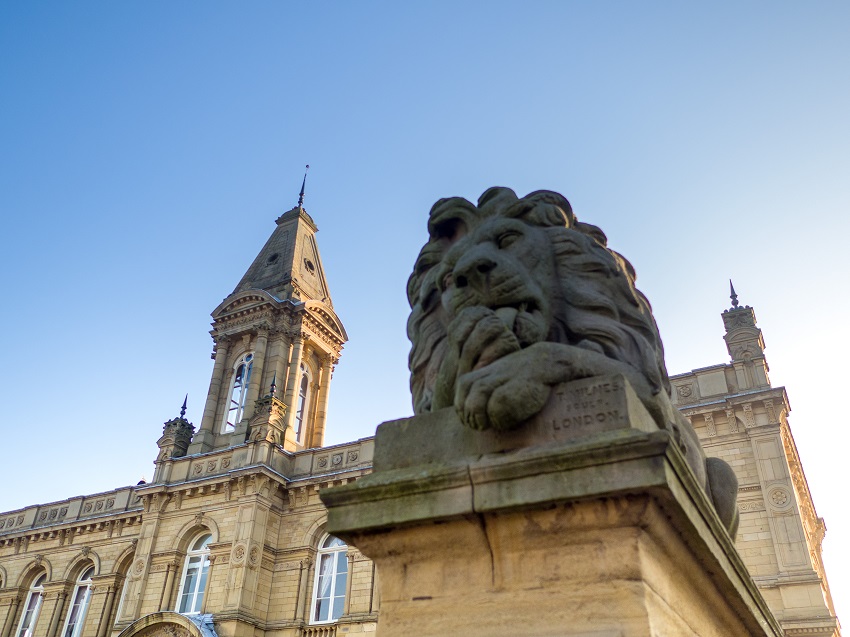
Saltaire World Heritage Site information and history

Photo copyright Drones on Demand Ltd
Saltaire takes its name from its founder, Sir Titus Salt (1803-1876), and the River Aire, which runs through the village. Salt made his fortune in the Bradford textile industry, manufacturing fine woollen fabrics. Determined to escape the polluted and overcrowded town centre for greener pastures, he made a bold decision to relocate his business and his employees.
Local architects, Henry Lockwood and Richard Mawson, were employed to plan a new community where Salt’s workforce would be healthier, happier and more productive. Work began in 1851 and continued until 1876. Salts Mill, a vast and ultra-efficient textile factory, was the first building to be complete in 1853.
Lockwood and Mawson designed the entire village in a classical style, inspired by the Italian Renaissance. Their finest work was the Saltaire Congregational Church (now the United Reformed Church), set in a spacious landscaped garden. Its ornamental bell-tower can be seen in views throughout the village. Once complete, the village comprised of over 800 high quality homes, two churches, a school, adult education institute, park, hospital, baths and wash house and almshouses for the elderly.
Saltaire was inscribed on the UNESCO World Heritage List in 2001. It was recognised for its international influence on town planning. It was also considered to be an outstanding example of a mid-nineteenth century model town that demonstrates the social and economic impact of the textile industry.
Saltaire’s World Heritage inscription can be viewed on the UNESCO World Heritage website.
Information about the history of Saltaire
- An introduction to the history of Saltaire can be found in the Nomination of Saltaire Village for inclusion on the World Heritage List
- Saltaire has a thriving history club with a regular programme of lectures, a Facebook group and the Saltaire History Club website with news, articles and a bibliography.
- The Saltaire Collection - based in Shipley College in Saltaire - contains an outstanding range of books, documents, photographs and objects relating to the village. More information, including historical articles, can be found on its website www.saltairecollection.org.
- The Saltaire Village website features articles on architecture, culture and heritage, social history and is a trove of continuing and updated research into the lives of people who lived and worked in Saltaire, courtesy of historian, Colin Coates.
Tourist Information
The following pages provide information on the conservation and management of the Saltaire World Heritage Site. If you are interested in visiting this fascinating village please visit our Tourist Information website
Saltaire is part of the European Route of Industrial Heritage, please visit the European Route of Industrial Heritage website for further details.
World Heritage Sites
UNESCO’s (United Nations Educational, Scientific and Cultural Organisation) World Heritage Committee is responsible for overseeing the protection of natural and cultural sites it has identified as being of global importance. On a day-to-day basis the care of these sites is the duty governments, organisations and property owners across the world. You can read more about World Heritage in the United Kingdom.
Saltaire's journey to World Heritage Status
The journey to World Heritage Site status for Saltaire was relatively short but not lacking in drama. For several years many local people had hoped that Saltaire might one day become a World Heritage Site. The first stage in this process was to be included on the United Kingdom’s Tentative List. Each country has to prepare a Tentative List of sites it believes are worthy of inclusion on the World Heritage List and submit it to the World Heritage Committee.
Between 1997 and 1999 the UK government reviewed its Tentative List and made visits to Saltaire and many other sites. However, when a consultation paper was published by the Department of Culture Media and Sport in August 1998, as a draft version of the Tentative List, Saltaire was not included. A concerted campaign was then launched to champion Saltaire’s case by the Saltaire Village Society, Chris Leslie MP and Bradford Council. The campaign was a success and in June 1999 Saltaire was one of just three sites to be included on the Tentative List after being overlooked at the draft stage.
There was no time for complacency however as Saltaire was selected in July 2000 with three other UK sites to be nominated for inclusion on the World Heritage List at the World Heritage Committee in December 2001. This left just six months for Bradford Council to co-ordinate all the necessary information contained in the Nomination Document and the Saltaire World Heritage Site Management Plan to meet the World Heritage Committee's strict deadlines.
In December 2001 the efforts of all involved were rewarded with Saltaire’s inscription on the World Heritage List.